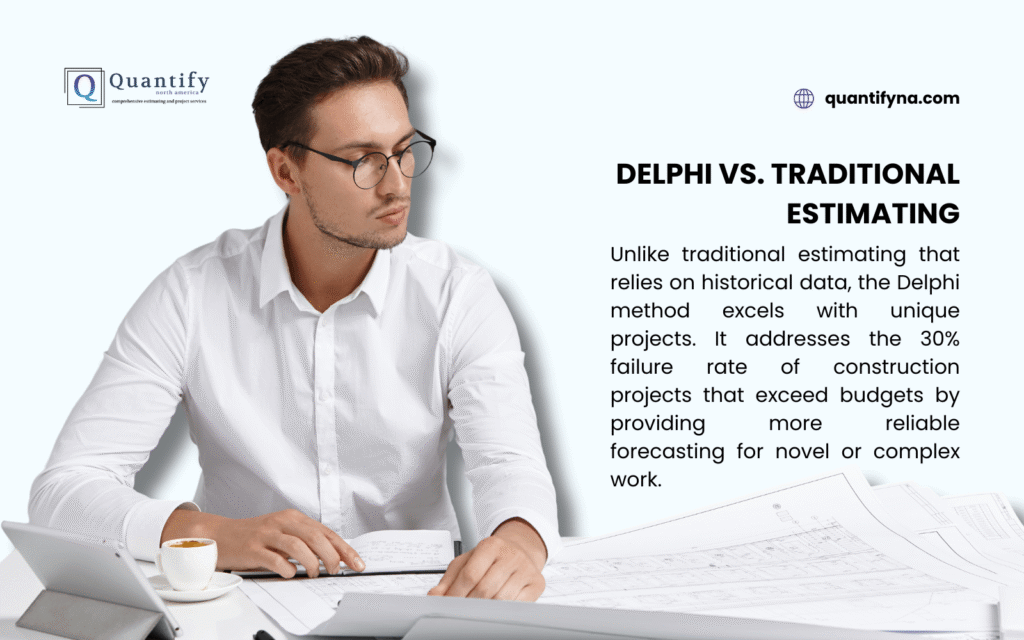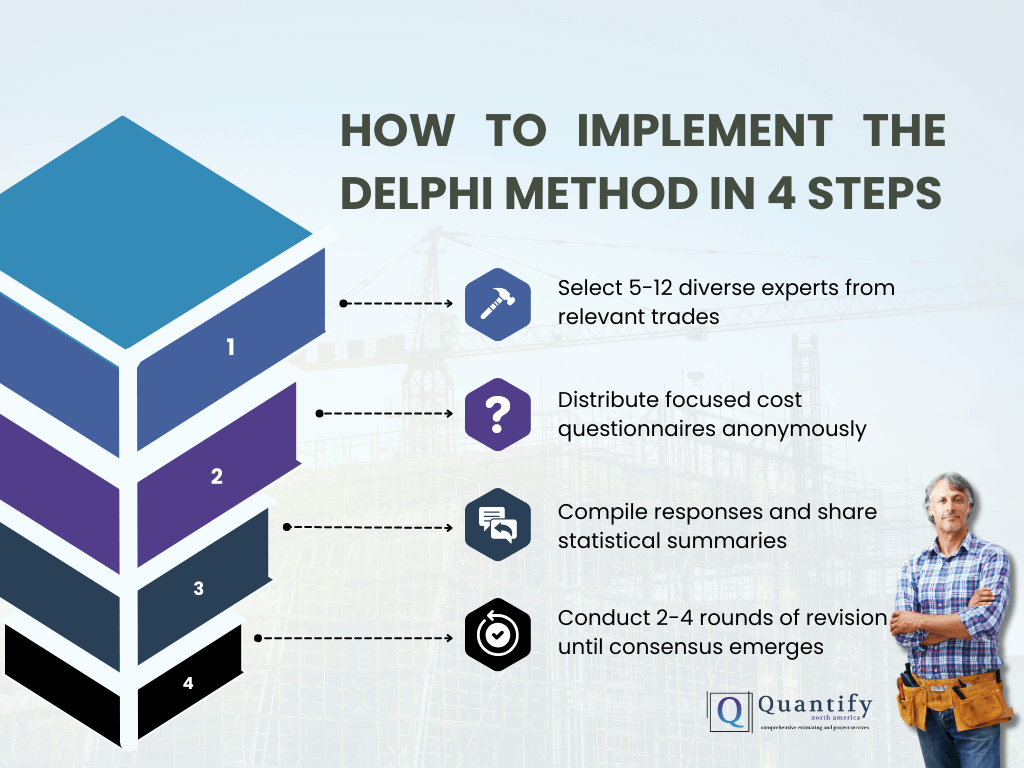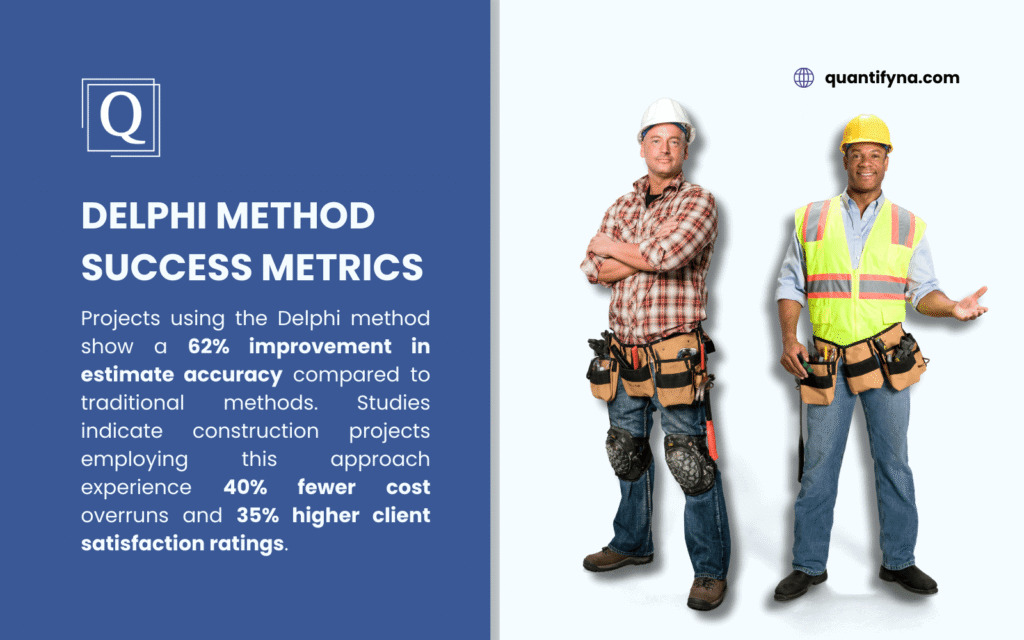Summary of This Article
This comprehensive guide examines the Delphi method and its practical applications in construction estimating:
- What the Delphi method is and its historical development
- How the Delphi method works in construction cost estimation
- Benefits and limitations when applied to construction projects
- Comparison with other estimation techniques like rough order of magnitude and definitive estimates
- Real-world applications and case studies in construction estimating
- Best practices for implementation in your construction business
What Is the Delphi Method?
The Delphi method serves as a structured communication technique for forecasting and decision-making. This approach relies on a panel of experts who answer questionnaires in multiple rounds. After each round, a facilitator presents an anonymous summary of the experts’ forecasts and their reasons. The experts then revise their earlier answers based on the replies of other members. Through this process, the range of answers decreases, and the group converges toward the correct answer.

The Delphi method got its name from the ancient Greek oracle at Delphi, who was believed to offer predictions of the future. Developed by the RAND Corporation in the 1950s, it was initially designed to forecast the impact of technology on warfare. Today, the method finds practical application across multiple industries, including construction estimating.
The Delphi Method Process in Construction Estimating
The Delphi method brings significant value to construction cost estimation through its systematic approach. The process typically follows these steps when applied to construction projects:
- Problem Definition: The estimation challenge is clearly defined, such as determining the cost of a complex commercial flooring project.
- Expert Selection: A diverse panel of construction professionals with relevant expertise is assembled. These may include estimators, project managers, trade specialists, and suppliers.
- Questionnaire Distribution: Participants receive a structured questionnaire asking for cost estimates and justifications.
- Anonymous Response Collection: Each expert submits their estimates independently, ensuring opinions remain unbiased.
- Analysis and Feedback: Responses are consolidated, analyzed, and shared anonymously with all participants.
- Revision and Refinement: Experts review the collective results and adjust their estimates based on new insights.
- Iteration: Steps 3-6 repeat until sufficient consensus emerges.
- Final Report: The facilitator produces a final estimate that represents the group’s collective expertise.
When applied to construction estimating, this method proves particularly valuable for projects with complex variables or limited historical data.
Benefits of Using the Delphi Method for Construction Projects
The Delphi method offers several advantages that make it especially useful for construction cost estimation:
| Benefit | Description |
| Expert Knowledge Integration | Combines diverse perspectives from multiple disciplines, creating more comprehensive estimates |
| Elimination of Group Bias | Anonymous participation reduces the influence of dominant personalities and groupthink |
| Structured Communication | Provides a formal framework for collecting and refining cost opinions |
| Consensus Building | Facilitates agreement among stakeholders on realistic project costs |
| Risk Identification | Helps uncover potential cost risks that might be missed by individual estimators |
| Improved Accuracy | Multiple rounds of refinement typically lead to more precise cost projections |
| Documentation | Creates a trail of expert reasoning that supports the final estimate |
A notable advantage is that the Delphi method works well when historical data proves limited or when dealing with novel construction techniques. For specialized trades like drywall estimating or flooring estimating, the collective expertise often produces more reliable figures than traditional formulas alone.
Limitations of the Delphi Method in Construction Estimating
Despite its many strengths, the Delphi method presents certain challenges when applied to construction cost estimation:
| Limitation | Description |
| Time Requirements | Multiple rounds of feedback make it slower than some other methods |
| Resource Intensity | Requires coordination of multiple experts, adding administrative overhead |
| Expert Availability | Depends on access to qualified professionals willing to participate |
| Potential for Conformity | Experts might gravitate toward the mean rather than defend outlier positions |
| Subjective Elements | Still relies on human judgment, which may contain inherent biases |
| Difficulty with Rapid Changes | May struggle to account for sudden market shifts between rounds |
| Implementation Complexity | Requires skilled facilitation to manage the process effectively |
The time required for proper implementation means the Delphi method works best when sufficient lead time exists. For urgent painting estimating needs, other approaches might prove more practical.
Comparing the Delphi Method with Other Estimation Techniques
The Delphi method represents one of several approaches to construction cost estimation. Understanding how it relates to other methods helps determine when to apply it:
| Estimation Method | Best Use Case | Accuracy Level | Time Required | Expert Input Needed |
| Delphi Method | Complex, unique projects | High | High | Multiple experts |
| Rough Order of Magnitude | Early conceptual phase | Low to Medium (±25-75%) | Low | Minimal |
| Definitive Estimate | Late design/pre-construction | Very High (±5-10%) | High | Significant |
| Analogous Estimating | Projects similar to past work | Medium | Low | Some |
| Parametric Estimating | Projects with measurable parameters | Medium to High | Medium | Moderate |
| Three-Point Estimating | Projects with uncertainty | Medium to High | Medium | Moderate |
| Bottom-Up Estimating | Well-defined scope | High | High | Significant |
When compared to analogous estimating or parametric estimating, the Delphi method proves more adaptable to unique scenarios where historical data may not directly apply. Many construction professionals find the Delphi method particularly valuable when developing estimates between a rough order of magnitude and a definitive estimate.

Practical Applications in the Construction Industry
The Delphi method finds practical application across various construction scenarios:
Complex Commercial Projects
For large commercial developments with multiple trades, the Delphi method helps coordinate expert opinions across disciplines. When estimating drywall costs for a complex office building, for example, experts can account for unique architectural features that standard calculations might miss.
Novel Construction Techniques
When projects incorporate innovative building methods or materials, the Delphi method allows experts to factor in their experience with similar innovations. This proves especially valuable when estimating costs for sustainable building features with limited historical data.
Risk Assessment
The method excels at identifying potential cost risks through multiple expert viewpoints. For flooring installation projects with unknown subfloor conditions, experts can collectively assess the probability and impact of various scenarios.
Market Volatility Response
In periods of price instability, the Delphi method helps account for divergent opinions about future material costs. For example, when estimating hardwood costs per square foot during supply chain disruptions, experts can provide informed projections based on their supplier relationships and market knowledge.
Dispute Resolution
When disagreements arise about appropriate costs, the Delphi method provides a structured approach to reaching consensus. This proves particularly valuable when reconciling differences between contractor and owner expectations.
Integrating the Delphi Method into Your Estimation Process
For construction companies seeking to implement the Delphi method, the following best practices should be considered:
1. Expert Panel Selection
The quality of results directly correlates with the expertise of participants. Include professionals with relevant experience in specific trades like drywall takeoff or painting estimating for specialized projects.
2. Clear Question Formulation
Develop precise questions that target specific cost components. Rather than asking for a general square footage price, break down questions by material, labor, equipment, and other relevant categories.
3. Anonymity Preservation
Maintain strict anonymity throughout the process to prevent opinion bias. This proves especially important when panel members represent different companies or have varying levels of authority.
4. Feedback Quality
Provide detailed summaries between rounds that include both statistical measures (median, range) and qualitative reasoning. This helps experts understand the basis for different opinions.
5. Iteration Management
Balance the need for consensus with practical time constraints. Most successful applications achieve sufficient convergence within three to four rounds.
6. Documentation Standards
Establish clear protocols for recording expert opinions and the rationale behind the final estimate. This documentation proves invaluable when explaining estimate foundations to project stakeholders.
7. Technology Utilization
Modern software platforms facilitate the Delphi process through automated questionnaire distribution, anonymous response collection, and results compilation. These tools significantly reduce the administrative burden.

Case Study: Delphi Method in Commercial Flooring Estimation
A commercial contractor faced challenges estimating costs for a complex retail space renovation involving multiple flooring types across irregular spaces. Traditional estimating methods produced widely varying results due to the project’s unique characteristics.
The contractor assembled a panel including:
- An experienced flooring estimator
- A project manager with retail renovation expertise
- A flooring manufacturer representative
- A skilled installation foreman
- A cost analyst with historical data expertise
Using the Delphi method, the panel underwent three rounds of estimation. Initial estimates varied by 23%, but by the final round, the variation decreased to just 7%. The resulting carpet cost per square foot and tile cost per square foot figures proved remarkably accurate, with final project costs coming within 5% of the estimate.
The success prompted the contractor to adopt the Delphi method for all complex flooring projects, leading to improved bid accuracy and profit margin reliability.
The Delphi Method for Different Project Phases
The application of the Delphi method varies throughout the project lifecycle:
| Project Phase | Delphi Method Application | Accuracy Expectation |
| Conceptual | Broad cost ranges and key cost drivers | ±25-40% |
| Schematic Design | Refined system costs and major material selections | ±15-25% |
| Design Development | Detailed trade breakdowns and specific material costs | ±10-15% |
| Construction Documents | Final quantity verification and contractor input | ±5-10% |
| Bid Validation | Reconciliation of differences between bids and estimates | ±0-5% |
During early phases, the method helps establish realistic budget parameters similar to a rough order of magnitude estimate. As the project progresses, the same structured approach refines those initial figures into increasingly precise projections.
Combining the Delphi Method with Modern Estimating Tools
The Delphi method pairs effectively with contemporary estimating technology:
Digital Takeoff Integration
Modern digital takeoff software provides precise quantities that serve as baseline inputs for Delphi participants. This combination leverages both technological accuracy and human expertise. Professional services like those offered by Quantify North America often utilize this integrated approach.
Historical Database Enhancement
When experts participate in Delphi sessions, their collective knowledge enhances historical cost databases. These improved databases then support future estimates, creating a continuously improving system.
Cost Modeling Synergy
The expert insights gained through Delphi sessions inform more sophisticated cost models. These models account for intangible factors that might otherwise be overlooked in pure data-driven approaches.
Remote Collaboration
Digital platforms enable Delphi participants to contribute regardless of geographic location. This expanded reach allows contractors to access specialized expertise across regions.
Machine Learning Applications
Emerging AI technologies can analyze patterns in Delphi responses over time, potentially identifying expert biases or particularly accurate contributors. This analysis further refines the process.
When to Choose the Delphi Method for Your Project
The Delphi method proves most valuable in specific scenarios:
| Project Characteristic | Delphi Method Suitability |
| High complexity | Excellent |
| Limited historical data | Excellent |
| Multiple stakeholders | Very Good |
| Tight timeline | Poor |
| Limited budget for estimation | Poor |
| High risk factors | Excellent |
| Standard, repeatable project | Fair |
| Novel materials or methods | Excellent |
For contractors facing unique challenges in drywall estimating, painting estimating, or flooring estimating, the Delphi method offers a structured path to reliable figures.
Modifying the Delphi Method for Small to Mid-Sized Projects
While traditionally associated with large projects, the Delphi method can be scaled for smaller applications:
1. Mini-Delphi Approach
A streamlined version uses fewer experts (3-5) and limited rounds (2-3) to accelerate the process while maintaining key benefits. This modified approach works well for projects like laminate flooring installation or attic insulation.
2. Hybrid Implementation
Some contractors combine Delphi elements with other methods, using expert panels for only the most uncertain aspects of an estimate. For example, standard costs might apply to carpet installation, while the Delphi method focuses on specialty items.
3. Digital Facilitation
Online survey tools and videoconferencing reduce administrative overhead, making the method more accessible for smaller teams. Some contractors effectively run Delphi sessions during normal team meetings with proper facilitation.
4. Focus Area Application
Rather than applying the method to an entire project, some estimators use it for specific high-risk or uncertain elements. This targeted approach maximizes value while minimizing resource requirements.

Expert Tips for Delphi Method Success
Construction professionals experienced with the Delphi method offer these recommendations:
- Select diverse experts: Include both senior and mid-level professionals to balance experience with fresh perspectives.
- Prepare participants: Brief experts on the process and expectations before beginning to improve response quality.
- Maintain momentum: Schedule rounds at regular intervals to prevent loss of engagement.
- Focus questions: Target specific cost elements rather than seeking overall project estimates.
- Document assumptions: Record the underlying assumptions behind each round’s estimates to provide context.
- Consider contingencies: Use the method to identify appropriate contingency levels based on risk factors.
- Evaluate results: Compare Delphi estimates with actual costs to refine the process over time.
- Combine approaches: Use the Delphi method alongside three-point estimating or top-down estimating for comprehensive results.
Avoiding Common Pitfalls with the Delphi Method
Even experienced estimators encounter challenges when implementing the Delphi method:
| Common Pitfall | Prevention Strategy |
| Expert fatigue | Limit rounds and streamline questionnaires |
| Selection bias | Ensure diverse panel composition across disciplines and experience levels |
| Rushed convergence | Allow sufficient time between rounds for thoughtful consideration |
| Inadequate feedback | Provide detailed statistical and qualitative summaries |
| Poor question design | Test questions for clarity before full distribution |
| Premature consensus | Watch for artificial agreement and encourage honest revisions |
| Implementation delays | Plan the Delphi timeline to align with project milestones |
Looking to the Future: The Delphi Method in Modern Construction
The construction industry continues to evolve, and the Delphi method adapts with it. Emerging trends include:
1. Integration with Building Information Modeling (BIM)
Experts can provide input on cost implications directly within BIM environments, creating a more intuitive estimation process. This integration particularly benefits complex drywall bids and other specialized trades.
2. Continuous Delphi Processes
Rather than discrete estimation events, some organizations implement ongoing panels that regularly review and refine cost data. This creates an ever-improving knowledge base.
3. Supplier and Subcontractor Inclusion
Forward-thinking companies expand their expert panels to include key suppliers and subcontractors, bringing material and labor insights directly into the process.
4. Cross-Project Learning
Sophisticated implementations track expert accuracy across multiple projects, identifying particularly reliable contributors for future panels. This data-driven approach enhances overall estimation quality.
5. Client Participation
Some contractors include client representatives in modified Delphi panels, creating transparency and shared ownership of cost expectations. This approach proves particularly valuable in collaborative delivery methods.
The Value of Professional Estimating Services
While the Delphi method offers numerous benefits, its proper implementation requires expertise and resources. Many contractors find value in partnering with professional estimating services like Quantify North America that offer:
- Trained facilitators experienced with the Delphi method
- Access to diverse expert panels across construction disciplines
- Established processes for efficient implementation
- Integration with comprehensive estimating services
- Technology platforms that streamline the process
These partnerships prove especially valuable when internal resources are limited or when facing particularly complex projects. By outsourcing construction estimating, contractors gain access to specialized expertise without expanding permanent staff.

Key Takeaways
- The Delphi method leverages structured expert opinion to create more accurate construction estimates.
- Anonymous participation reduces bias and groupthink, leading to more objective results.
- Multiple feedback rounds refine estimates to reflect collective expertise.
- The approach proves particularly valuable for complex, unique, or high-risk projects.
- Modern implementations combine the Delphi method with digital tools and databases.
- Scaled versions make the approach accessible for smaller contractors and projects.
- Professional estimating services can facilitate the Delphi process for optimal results.
Ready to Enhance Your Estimation Accuracy?
Construction projects benefit from precise cost projections based on expert consensus. The Delphi method offers a structured approach to achieving this accuracy, particularly for complex or unique projects.
Quantify North America specializes in providing comprehensive estimating services that incorporate expert methodologies like the Delphi method. Their team delivers accurate estimates for flooring, drywall, and painting projects of all sizes.
Contact their team today to learn how professional estimating services can improve your project outcomes and profitability through precise cost projections that account for all variables.




